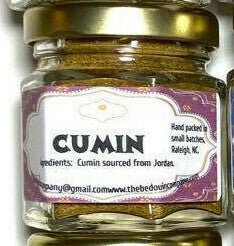
Herb of the Month for January: Cumin
Cumin (Latin name: cuminum cyminum)

The aromatic and flavorful seeds are actually fruit from the cumin plant, a member of the parsley family. Cumin seeds are harvested by hand. Shaped like little boats, they are often brownish-yellow in color, although they can also be found in black, green and white. Cumin has a warm, earthy flavor and aroma with a bit of both sweetness and bitterness.
Cumin is said to have originated more than 5000 years ago in Iran while archaeological excavations in Syria and Egypt revealed its use 1400 BC and earlier. Ancient Egyptians used the spice to preserve mummies. The ancient Greeks and Romans kept containers of the spice on their tables using it as a spread (much like we do peanut butter). Cumin is referenced in the Old and New Testaments (its planting for beneficial farming practices as ascribed as coming from God).
In the Middle Ages when spices were rate, cumin was one of the commonly-found spices. Thought to promote love and fidelity, people carried cumin cakes (or bread) around in their pockets. Women baked these cakes for their spouses believing it would keep their men faithful and return them safely home after long journeys.
Cumin made its way into Central and South American cuisine by way of Spanish and Portuguese colonization. It is a major ingredient in chili and curry powders. It is associated mostly with Indian, Mexican, and Vietnamese foods, but also meats, pickles, cheeses, sausages, soups, chilies, and stews.

Cumin is available as whole seeds or ground powder. Whole cumin is often featured in Indian dishes. It’s usually added at the beginning of cooking to allow the seed to infuse the oil and other ingredients. Ground cumin, made from grinding dry roasted cumin seeds, can be added at any time to a recipe as its flavor doesn't need heat or time to be released.
Recipes
- Red Lentil Soup (Turkish Mercimek or Arabic “Adas”)
- Hummus
- Falafel
- Cumin-Roasted Carrots